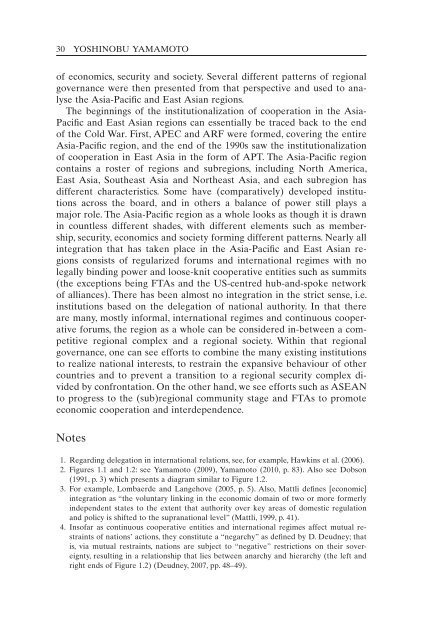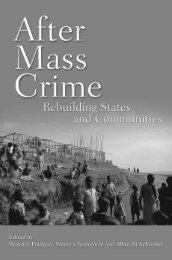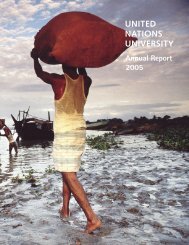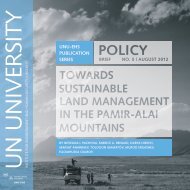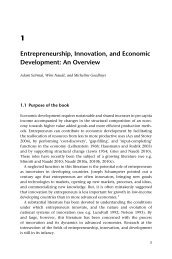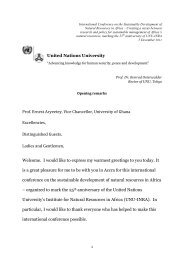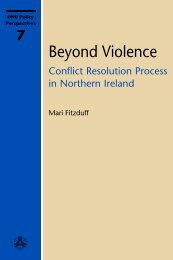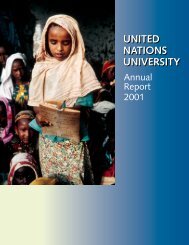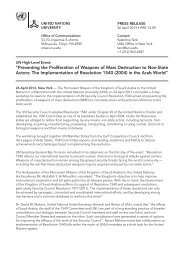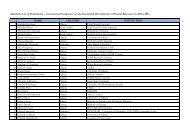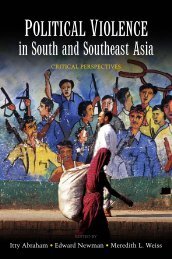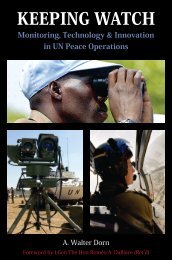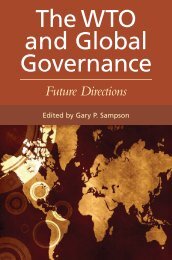Sample Chapter - United Nations University
Sample Chapter - United Nations University
Sample Chapter - United Nations University
You also want an ePaper? Increase the reach of your titles
YUMPU automatically turns print PDFs into web optimized ePapers that Google loves.
30 Yoshinobu Yamamoto<br />
of economics, security and society. Several different patterns of regional<br />
governance were then presented from that perspective and used to analyse<br />
the Asia-Pacific and East Asian regions.<br />
The beginnings of the institutionalization of cooperation in the Asia-<br />
Pacific and East Asian regions can essentially be traced back to the end<br />
of the Cold War. First, APEC and ARF were formed, covering the entire<br />
Asia-Pacific region, and the end of the 1990s saw the institutionalization<br />
of cooperation in East Asia in the form of APT. The Asia-Pacific region<br />
contains a roster of regions and subregions, including North America,<br />
East Asia, Southeast Asia and Northeast Asia, and each subregion has<br />
different characteristics. Some have (comparatively) developed institutions<br />
across the board, and in others a balance of power still plays a<br />
major role. The Asia-Pacific region as a whole looks as though it is drawn<br />
in countless different shades, with different elements such as membership,<br />
security, economics and society forming different patterns. Nearly all<br />
integration that has taken place in the Asia-Pacific and East Asian regions<br />
consists of regularized forums and international regimes with no<br />
legally binding power and loose-knit cooperative entities such as summits<br />
(the exceptions being FTAs and the US-centred hub-and-spoke network<br />
of alliances). There has been almost no integration in the strict sense, i.e.<br />
institutions based on the delegation of national authority. In that there<br />
are many, mostly informal, international regimes and continuous cooperative<br />
forums, the region as a whole can be considered in-between a competitive<br />
regional complex and a regional society. Within that regional<br />
governance, one can see efforts to combine the many existing institutions<br />
to realize national interests, to restrain the expansive behaviour of other<br />
countries and to prevent a transition to a regional security complex divided<br />
by confrontation. On the other hand, we see efforts such as ASEAN<br />
to progress to the (sub)regional community stage and FTAs to promote<br />
economic cooperation and interdependence.<br />
Notes<br />
1. Regarding delegation in international relations, see, for example, Hawkins et al. (2006).<br />
2. Figures 1.1 and 1.2: see Yamamoto (2009), Yamamoto (2010, p. 83). Also see Dobson<br />
(1991, p. 3) which presents a diagram similar to Figure 1.2.<br />
3. For example, Lombaerde and Langehove (2005, p. 5). Also, Mattli defines [economic]<br />
integration as “the voluntary linking in the economic domain of two or more formerly<br />
independent states to the extent that authority over key areas of domestic regulation<br />
and policy is shifted to the supranational level” (Mattli, 1999, p. 41).<br />
4. Insofar as continuous cooperative entities and international regimes affect mutual restraints<br />
of nations’ actions, they constitute a “negarchy” as defined by D. Deudney; that<br />
is, via mutual restraints, nations are subject to “negative” restrictions on their sovereignty,<br />
resulting in a relationship that lies between anarchy and hierarchy (the left and<br />
right ends of Figure 1.2) (Deudney, 2007, pp. 48– 49).


